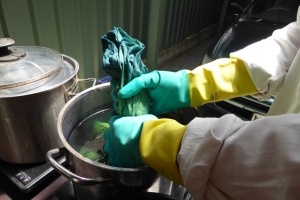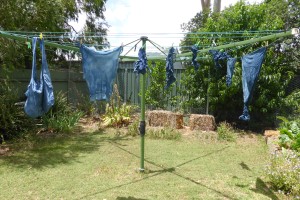When the big day arrived, I had more company than initially expected, with two of our beloved friends staying with us and keen to try indigo, and more coming over. I have to say, I am intimidated by indigo and it was a holiday project that kept me nervous, planning this indigo dyeing day. What if it didn’t work out? What if my ignorance trumped my effort? What if people were bored? What if nothing worked and people’s things were ruined? The funny thing about fret is that so often it has me focused on myself and my overdeveloped sense of responsibility, and that’s neither sensible, nor fun, nor realistic. How could I even temporarily forget how wonderful my friends are, in the face of fret? Everyone who came knew at least some of the other folk and it was such a generous and friendly gathering. One of my near and dear spent the day taking photographs, so a big thanks to her for those that follow…
We practised our skills at getting fabric into and out of the dye without adding needless oxygen.
This time I had a dependable thermometer and used it!
I also now have a Ph meter. My dear Dad asked what I wanted for my birthday last year and when I said I wanted a Ph meter but wasn’t sure where to get one he had the answer!!! You don’t know him, but eBay, my friends, is the answer to a shocking number of things for Dad…
There wasn’t just the fructose vat. I have decided that aiming for fermentation and fructose vats is a good long term goal for environmental, health and all kinds of other reasons (pure curiosity, for a start…) and I am growing woad and indigofera australis and Japanese indigo. However, I have decided that in the interim, colour run remover (mostly sodium hydrosulphite) can rescue failures in my judgment and experience and save wastage of indigo. Since I have some synthetic indigo, I decided to use that in any hydrosulphite vats as it may not be so suitable for fermentation or fructose vats. There was a lot of fabric when everyone piled in–so I set up two hydrosulphite vats and was delighted not to need to use hydrosulphite to troubleshoot the fructose vat.
This is something-or-other coming out of one colour run remover vat quite yellow and beginning to turn blue as the air strikes it. For these vats, I tried Jenny Dean’s recipe for a colour run remover indigo vat from Wild Colour. It worked really well and uses washing soda, a much milder alkali than some proposed in other books. It’s also designed for colour run remover and not pure hydrosulphite–and that is what I had. The fructose vat smells MUCH better!
I love this process of transformation! The best item of all for this effect was a pair of pants tied around a length of garden hose. It was long enough to be yellow at one end, green in the middle and various shades of blue as it slowly emerged from the pot. My friends had been out researching techniques for resist–so there was stitching, wrapping, bundling, string, thread, rubber bands–and even wax resist, some applied with a biscuit cutter and some freehand.
With three vats going, and regular monitoring of temperature and Ph and so on, the scene at the clothes line kept changing.
There were whole-garment makeovers, a purpose made bag, scrap fabrics, an opportunistic bag makeover and the pieces for a pair of pants yet to be made.
The shades kept changing–wet to dry and dip to dip.
…Until finally we had done all we could do and time to head to our various homes started to arrive. Then there was a lot of undoing and exclaiming… and I’ll save that for another post!











looks like huge fun. I have never tried synthetic indigo/hydrosulphite. today is my big day too – have loads of things shibori-ed up and two big silk dresses in the washing machine right now making sure they are clean and damp for the vat. the first time I only did one dip as I wanted a pale blue, but I was told I should do two shorter dips. when I tried it I did get a deeper colour, so it’s a bit nerve-wracking … should I do 1 x 2 minutes, or 2 x what, maybe 45 secs …. eeeeek. also been reading scary posts on fb about indigo dyed stuff fading rapidly. but that may have been due to their tap water having a high alkaali value. mine is about 7. Michel says to rinse with vinegar in the water after the main rinse session.
LikeLike
Another great tip… Your dyeing day sounds amazing! But yes, this is another dyeing process where there are a lot of different factors influencing outcome. Happily there are a lot of lovely shades of blue…
LikeLike
apropos of nothing in this post, do you know about the koala mitten project? http://www.ifaw.org/sites/default/files/default/KOALA-MITTENS-PATTERN-A4.pdf
LikeLike
I saw this on the front page of the newspaper! There was a project knitting little coats for penguins whose feathers had been damaged by oil spills a while back and they got so many they couldn’t use them all!
LikeLike
I guess the (sad) thing about the koala mittens is there will always be a need as long as there are bushfires….
LikeLike
And the sad thing is that there are no shortage of bushfires 😦
LikeLike
What a blast!!! good friends and good results….no matter what 🙂
Even in the states I had heard re the Koala mitten project and sent it on to an email friend in AU. You guys all ROCK!!
LikeLike
Thanks, Susan! Yes, time spent with friends is always a treasure…
LikeLike
Wow I really need to try this…. unfortunately I missed out on India/Roz @ Mt Tamborine.( just a stones throw from home) Will have to find another tutor around this area.
LikeLike
So sorry you missed pout on Mt Tamborine! It sounds pretty amazing, and clearly–so local to you. Surely there is someone else you can learn from…
LikeLiked by 1 person
the great thing is you can make a teeny little vat and still have good results 🙂
LikeLike
Yes, I’ve been wondering about treating indigo as a more everyday process and keeping a very small vat to wake up now and then…
LikeLike
can anyone tell me how to stop indigo dye leaching out of vintage Japanese cotton fabric pieces prior to assembling quilt pieces. I need completed work to be washable and not bleed into other fabrics that I’m using.
LikeLiked by 1 person
Hello Candy, I am surprised vintage fabrics would shed dye. I would try soaking them in soy milk and then washing them more than once.
LikeLike
technically indigo dye cannot stain other fabrics, because it needs the conditions in the vat to fix it to fibre, ie no oxygen etc. indigo is a completely different dyeing system to any using soy etc. we use a small amount of vinegar in the rinse to help restore the fibre the correct ph to stop any further reaction after dyeing, so that would be the only thing I could think of.
LikeLiked by 1 person
I agree. The soy theory is more that it bonds to free indigo particles, removing them more readily than rinsing in water. It won’t cause the indigo to bond to the fabric if it did not do so in the vat.
LikeLiked by 1 person
of course it will rub off onto other fabrics if there are loose indigo particles, but this will wash off. maybe this is what has given Candy the impression that indigo fabrics will stain others.
LikeLiked by 1 person
Ah! Thanks for sorting me out.
LikeLike